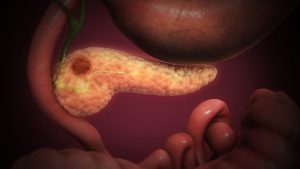 Pancreatic cancer was the third leading cause of cancer-related death in the United States in 2018. This year, experts estimate that 56,770 new cases will be diagnosed and 45,750 deaths will be recorded. Pancreatic cancer is especially lethal because in its early stages, when the disease is easiest to treat, patients are usually asymptomatic. The disease is typically diagnosed in its advanced stages when symptoms such as abdominal pain or jaundice may appear. Additionally, no general screening tools for pancreatic cancer currently exist.
Pancreatic cancer was the third leading cause of cancer-related death in the United States in 2018. This year, experts estimate that 56,770 new cases will be diagnosed and 45,750 deaths will be recorded. Pancreatic cancer is especially lethal because in its early stages, when the disease is easiest to treat, patients are usually asymptomatic. The disease is typically diagnosed in its advanced stages when symptoms such as abdominal pain or jaundice may appear. Additionally, no general screening tools for pancreatic cancer currently exist.
Pancreatic cancer cells are also hard to treat because they can effectively repair DNA damage caused by chemotherapy and radiation therapy, the two therapeutic interventions mainly used against this tumor. However, recent developments cast a new light on pancreatic cancer treatment. A new drug from AstraZeneca, AZD1775, appears to prevent the “shielding” of pancreatic cancer cells from these common treatments. The drug blocks an enzyme called Wee1 and disables the tumor’s DNA damage repair response, ultimately sensitizing the cancer to the effects of radiation and chemotherapy. In a small Phase 1 clinical trial conducted at the University of Michigan, 34 pancreatic cancer patients whose tumors were too advanced to be removed with surgery were treated with a combination of AZD1775, radiation and gemcitabine. The median survival rate in those treated with the combination increased to over 22 months, compared to 12-14 months for patients treated with gemcitabine alone. AstraZeneca is now planning a Phase 2 study of this combination therapy in pancreatic cancer. AstraZeneca is also testing AZD1775 as both a single agent and in combination with other agents in more than 50 trials against a variety of solid tumors.
Preventing pancreatic cells from repairing DNA is just one of several innovative ideas currently being investigated as a treatment for this tumor.
For example, Rafael Pharmaceuticals is developing CPI-613 (devimistat) as a way to target the mitochondrial metabolism (Krebs cycle) and alter the production of energy that tumor cells need to survive and multiply. In an initial Phase 3 trial in metastatic pancreatic cancer, the combination of CPI-613 with the chemotherapeutic regimen FOLFIRINOX showed an overall response rate of 61% and a median overall survival of 20 months, compared to a 32% response rate and 11 months median survival for the chemotherapy alone. Clinical investigations with devimistat are continuing, both as a single agent and in combination therapies.
Recent preclinical research is also opening new avenues for attacking the disease by restoring pancreatic tumor vascularization or altering extracellular barrier formation
New research conducted at the University of Pennsylvania suggests that pancreatic cancer cells attack the surrounding blood vessels that are supposed to deliver drugs to the tumor, thereby decreasing the effectiveness of the treatments. The researchers used “organ-on-a-chip” technology to show the ability of tumor cells to kill surrounding blood vessels. They found that manipulation of molecular messaging underlying the tumor’s progression via the TGF-β system led to an increase in the density of blood vessels around the tumor and slower tumor growth. In particular, inhibiting the kinase ALK7 had the greatest effects in both chip and mouse studies. ALK7 inhibitors are already being investigated in other indications, and thus studies in pancreatic cancer are likely to begin in the near future.
In addition, some pancreatic tumors overproduce a protein called perlecan that acts on remodeling of the extracellular matrix. These processes enable cancer cells to migrate to other parts of the body and also seem to shield cells from chemotherapy agents. Researchers from the Garvan Institute of Medical Research in Sydney (Australia) showed in a mouse model that when matrix fibroblasts from both metastatic and non-metastatic pancreatic tumors were combined, the previously non-metastatic cells started to break out of the matrix and travel. They then showed that lowering perlecan levels in mice via gene editing caused a drop in tumor metastasis and an improvement in the tumor response to subsequent chemotherapy. The researchers believe it will be possible to identify genetic changes in pancreatic tumors that cause them to become aggressive, and then target fibroblasts in those patients with perlecan-reducing therapies before employing chemotherapy. Such a strategy could potentially make the tumors more responsive to currently available treatments.